Usually when people think of beginning a new diet, they envision having to summon the strength to turn down all the tasty foods they love. Muster up the willpower to cut out the bad stuff, and only eat the good. But what if there was a way to switch to a better diet without being tempted by unhealthy foods? Some now say the solution is to not leave any room, literally, for craving cruddy food.
Crowding Out Unhealthy Foods
The term, “crowding out,” refers to simply incorporating more healthy foods to your diet, in addition to what you’re already typically consuming. The Institute of Integrative Nutrition (a nutritional training certification program) seems to have coined the phrase, but I have seen it used outside of their sphere of “health coaches.”
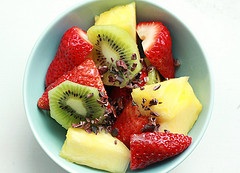 The theory is that, as long as you eat the healthier choices first, your body will be getting those important nutrients regardless of what follows onto your plate, and you will end up eating less of your favorite unhealthy choices, as you will likely feel more satiated from the nutrient-dense food. You’re advised to just add in the good stuff, without sacrificing the bad foods you crave. Eventually, you’ll want those foods less and less.
The theory is that, as long as you eat the healthier choices first, your body will be getting those important nutrients regardless of what follows onto your plate, and you will end up eating less of your favorite unhealthy choices, as you will likely feel more satiated from the nutrient-dense food. You’re advised to just add in the good stuff, without sacrificing the bad foods you crave. Eventually, you’ll want those foods less and less.
For example, if you usually eat donuts for breakfast, “crowding out” would have you instead eat maybe yogurt and fruit for starters. That doughnut might not be quite as appetizing afterward, though if you still wanted to, you could have it. Maybe you’d only feel like having a few bites at that point. The idea is to not force yourself to give up anything, which helps to ease into the transition.
Cutting Out Unhealthy Foods
Like I mentioned earlier, most people transitioning to any sort of a new diet (however unhealthy it may be in actuality — low-fat, vegan, etc.), tend to focus the most on restricting those foods which they are no longer “allowed.” The above scenario becomes, “I can’t have that doughnut — I’m on a diet.”
The idea of giving up foods that you’re used to eating turns many people off from making diet changes. Even with a traditional foods diet, it can be hard for people to adjust to cutting out all those convenient, processed foods.
With the conventional idea of a “healthy” diet, however, cutting out supposedly unhealthy foods means cutting out many of the foods that are the tastiest — butter, whole-fat dairy, fat-filled (as opposed to lean) meats, cholesterol-rich foods, etc. Of course, for those who eat traditional foods, we know that all that good stuff actually IS healthy, thankfully.
A real, traditional foods perspective
Crowding
A Real Foodie could crowd-out the non-traditional foods by focusing on adding in:
- Healthy fats
- Raw, whole, grass-fed dairy
- Real, grass-fed meats
- Organ meats
- Pastured eggs
- Properly prepared (soaked, sprouted, or soured) whole grains (unless choosing to avoid grains entirely)
- Properly prepared beans (soaked) and organic vegetables (some veggies are unhealthy to consume raw)
- Fermented foods and beverages (vegetable ferments, kefir, kombucha, yogurt, etc.)
- Healthier sweeteners in moderation (honey, rapadura, grade B maple syrup)
Cutting
A Real Food diet would have you restrict and avoid the following:
- Processed sugars
- Vegetable oils
- Improperly prepared or processed grains
- Factory-farmed meats
- Soy (unless properly, traditionally fermented)
- Any processed foods (especially anything made to be “low-fat”) and the additives and chemicals within them
What makes the most sense for eating real?
I think there is room for a compromise between the two strategies. The most important thing to do, in my opinion, is just to start learning how to replace fake food with real food. Crowd and cut, all at once.
I have a friend (Danielle, co-founder of Primal Unite) who eats a “paleo” or “primal” diet, but she is very accepting of other ways of eating with a similar focus — WAPF, whole foods, even raw vegan diets. She maintains that the most important thing, which all these have in common, is what we don’t eat — refined sugars, vegetable oils, processed foods — and that avoidance of this is what affects your health the most. While avoiding all animal-based foods (as with a raw vegan diet) is not the best way to properly nourish your body, it will still likely have a profound effect on your health in a positive way (at least for a while), given that you would no longer be consuming all the toxic, processed foods standard to the American diet. I think she has a very good point.
Although I wouldn’t condemn anyone for not immediately clearing out their cupboards of any and all processed foods, sugars, vegetable oils, or other real food no-no’s, I do think you should absolutely avoid purchasing those things once you have learned how destructive they are to your health. In that sense, I believe you should immediately begin “cutting” out those foods.
But while cutting out those toxic foods is certainly going to be very beneficial to your health, I would say it’s of equal importance to start swapping them with the most nutrient-dense foods you can as soon as possible. For example, you should definitely stop cooking with toxic vegetable oils. Therefore, you need to start cooking with real fats, such as lard, butter, or coconut oil.
It doesn’t have to be about restricting yourself of the foods you crave. Love your processed, store-bought Ben & Jerry’s? Make wholesome ice cream yourself, with fresh, raw (or even kefired!) cream, raw honey, and pastured eggs. Can’t do without your Dr. Pepper? Learn to make delicious water kefir soda. McDonald’s french fries look too tempting? Chop up some organic potatoes and fry them in tallow.
I think the biggest takeaway for me is that real food is GOOD food. It’s the stuff that everyone loves. Saturated fat, real, red meats, raw, whole dairy — everything that we’ve all been told to avoid like the plague from the Diet Dictocrats. What we now know are actually the healthiest choices for our diet and our health. It’s not hard to get used to eating all the delicious things allowed on a traditional foods diet!
But, it does take some work — avoiding the processed S.A.D. generally means learning to work your way around a kitchen a heck of a lot more than you may be used to — still, it’s so incredibly rewarding, and much easier than simply mustering up enough willpower to say “no” to your standard diet.
So, I say, cut out the worst food offenders straight away — toxic, processed foods, sugars, and oils — and learn to love real food again. Crowd in what you like best. Slather on that butter. Drink up that raw, whole milk. Eat every last bit of that juicy steak — marbled fat and all. And just see how good those icky chips, soda, and cookies from the inner corners of the grocery store sound to you then!
(Oh but that Krispy Kreme up there? No worries. It still looks amazing to me, too. I’m working on finding a Real Food replacement for it!)
What was your strategy in transitioning to a real, traditional foods diet? What do you think is the best way to convert to a healthy diet?
{This post is linked to Simple Lives Thursday!}
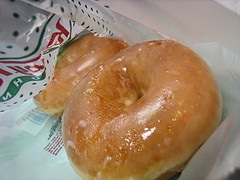
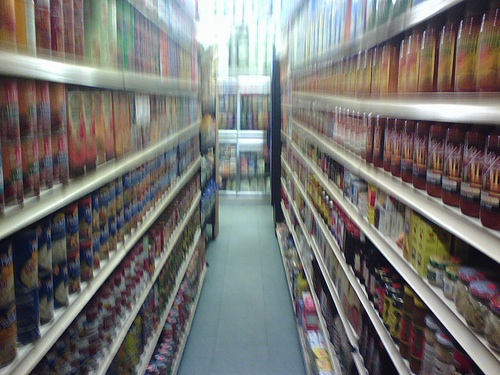
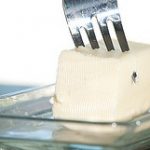


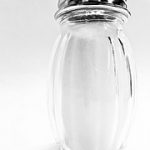
Great post Emily! I can say from experience that you are 100% correct. When we cut out our “offender foods” and started eating whole foods, we actually craved the “bad foods” less. I haven’t had a craving for Tootsie Rolls in MONTHS. It really is true. 🙂
Whole Foods are delicious!
Thanks, Stacy! Haha, I used to loooove me some Tootsie Rolls too. Thankfully, there are so many other delicious things we can eat that are actually healthy, huh?! I love that you converted to real, whole foods and told your story on your blog so openly. I’m sure you’ve inspired lots of readers to make the switch!
Excellent post! I’m just getting started eating real foods myself. Still have a ways to go on the sugar and white flours though… Cheers!
-nikki
Thank you Nikki! I feel you… I am still battling the remains of a major sugar and processed grain addiction. We’ll get there!
Great post Emily. I think people will find it helpful if they are struggling to take steps towards healthy eating. There are so misconceptions around which fats to eat and so many of our foods are laden with some from of toxic sucralose.
I tweeted it!
Thank you so much France!! The more we can all spread the word and dispel the myths and misconceptions surrounding nutrition, the healthier we will all become!
Hi there,
I came across your website via the article on the Susan G. Komen foundation (great article by the way) and have been looking around the site. I’ve seen in a few places that you mention a vegan diet is not good ling-term but can’t find any specifics. What are yoyr thoughts on it? My husband and I are *mostly* vegan, but occasionally buy cheese, although not much. We juice a lot and I cook bean dishes with fresh veggies several times a week. We use almond and coconut milk and occasionally we use tofu or tempeh in dishes.
Anyway, just wondering what it is about vegan diets that you feel is lacking. Oh, and I had low B12 levels several years ago (while I was still consuming meat) so I take shots and also use nutritional yeast in our dishes.
Thanks,
Julie
Hi, Julie! Thank you so much for your comment, and compliments! 🙂
I think it’s great that you and your husband are trying your best to eat a healthful diet. But yes, I do believe that a vegan diet is not a healthful choice and can actually be quite harmful when adhered to for long periods of time. It can, however, be used as a tool for cleansing purposes, short-term.
In a nutshell, a vegan diet is lacking in key, critical nutrients which the human body needs to survive. Fat soluble vitamins A, D-3, E, and K, as well as B-12 are only present in ample, bio-available form in animal foods.
You’re wise to be concerned with your B-12 levels, and to be doing the best you can to supplement since you’re not getting them from your diet. B-12 is present in nutritional yeast, however, this is only because it’s added in. It doesn’t occur naturally in the yeast. Unfortunately, despite what the vegan world will tell you, there are no true plant-based sources of vitamin B-12. There are plant sources of what are known as B-12 analogues, however, these are totally bio-unavailable — we can’t assimilate them. True, usable B-12 only comes from animal sources.
So, given that information, and that in order to survive on this diet you need synthetic supplementation of this key nutrient (as well as others), it becomes pretty obvious that this is not a diet humans were designed to consume.
That said, if you simply don’t care for meats — that’s fine! There’s nothing wrong with being a vegetarian, as long as you make sure to eat plenty of eggs, dairy, and ideally, cod liver oil (though of course, that comes from a meat). If you have allergies to those things, well, that’s a whole other issue, but that’s actually reversible.
Anyway, I think you guys are definitely on the right track with the inclusion of whole foods, juicing, etc. But if you’re still not convinced that an omnivorous diet is more healthful than a vegan one, I’d try to do a little more research from *unbiased* sources to better understand the facts. This article is a great starting point:
http://www.westonaprice.org/vegetarianism-and-plant-foods/myths-of-vegetarianism
Thanks again so much for stopping by. You should come visit us on Facebook — a lot of the people who “like” our page are much more knowledgeable about this stuff than me and can help to answer any other questions you might have!
WOW..that was absolutely delightful to read. I think you are truly on to something here. I can’t wait to try raw butter. But, you say no oil? Olive oil too?
Woah woah woah,
Love your site btw, but you went too far when you bashed Ben n Jerry’s 😀 j/k That and store bought pizza are my last guilty pleasures.
HA! Mark, I’ve changed my mind. Please don’t ever stop eating Ben n Jerry’s!
Really though, I kinda cringe a little bit reading this post (it’s from quite a while back). I don’t think taking out every last processed food (and replacing them with homemade versions) is all that important. I think the priority really just needs to be educating yourself on what is and isn’t healthy, and then making reasonable choices from there. I’m just not about labeling “forbidden foods” anymore. I think that’s counter-productive and unhealthy to do. I guess the only exception to that, for me, would be PUFA oils. But still, like those Krispy Kremes up there? Definitely fried in veggie oil. And I will definitely eat one if I feel like it! But like, I’m never gonna pick up a bottle of soybean oil at the store again, know what I mean?
Anyway. If BnJ’s is your Krispy Kreme, you go ahead and eat it! Without ever beating yourself up over it. 🙂